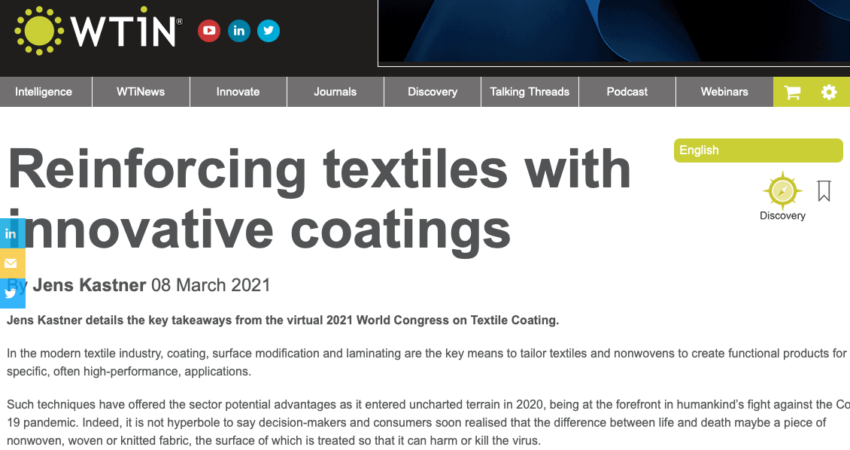For World Textile Information Network
In the modern textile industry, coating, surface modification and laminating are the key means to tailor textiles and nonwovens to create functional products for specific, often high-performance, applications.
Such techniques have offered the sector potential advantages as it entered uncharted terrain in 2020, being at the forefront in humankind’s fight against the Covid-19 pandemic. Indeed, it is not hyperbole to say decision-makers and consumers soon realised that the difference between life and death maybe a piece of nonwoven, woven or knitted fabric, the surface of which is treated so that it can harm or kill the virus.
Textile coating innovations have played a key role in enabling such functionality and were a hot topic at the World Congress on Textile Coating (WCTC). The event was hosted virtually on February 11-12 and 18-19 (2021), with dozens of presenters offering expertise. At this practical, industry-focused conference, experts shared real-world problems in the dedicated discussion forums.
NAVIGATING THE PANDEMIC
Conference chair Adrian Wilson stressed that coating, surface modification and lamination has become an especially significant topic for the nonwovens segment.
“Meltblown was already a bottleneck for diaper producers, even before demand for facemasks exploded in 2020”said Wilson. “And in order to be effective against bacteria and viruses, the meltblown layers in facemasks have to be electrostatically charged.
“But, at the onset of the pandemic, a lot of the stockpiled facemasks were found to be no good as they had lost their charge over time because they had not been stored properly,” he added.
As a result, researchers increasingly assessed the integration of graphene coatings, which could allow facemasks to be used many times. Graphene also possesses powerful antiviral properties – studies show that monolayered sheets of graphene oxide, which are very sharp-edged at the nanolayer, physically puncture viruses before they can enter the body, rendering them harmless.
In addition, negative electrostatic charges administered to the graphene oxide increase the material’s effectiveness at drawing viruses toward the sharpened edges.
Consequently, during 2020, a number of commercial companies introduced graphene-coated facemasks to the market.
In one example singled out by Wilson, the outer layer of the Anti-SARS-CoV-2 Graphene Plus Co-Mask, made by Directa Plus, in Italy, benefits from a functional graphene nanoplatelet print, its Planar Thermal Circuit (PTC).
Continue reading: https://www.wtin.com/article/2021/march/080321/reinforcing-textiles-with-innovative-coatings/













Verwandte Artikel
Taiwan Enters Age of Private 5G Networks
The 5G sector is anticipating a revolutionary “iPhone moment” as new technology helps companies in a range of fields pay less, earn more, and become more autonomous. For Taiwan Business…
Continue »
Coping With Carbon Controls
Taiwan’s metals, plastics, and chemicals manufacturers will need to adapt to new international policy measures to secure price competitiveness in key export markets. for AmCham’s Taiwan Business Topics When the…
Continue »
Taiwan’s Logistics Sector Enters Choppy Waters
A dramatic shift in supply and demand has put many logistics companies in hazardous positions. But up-and-coming market segments and technology could present new opportunities for the industry. For AmCham…
Continue »